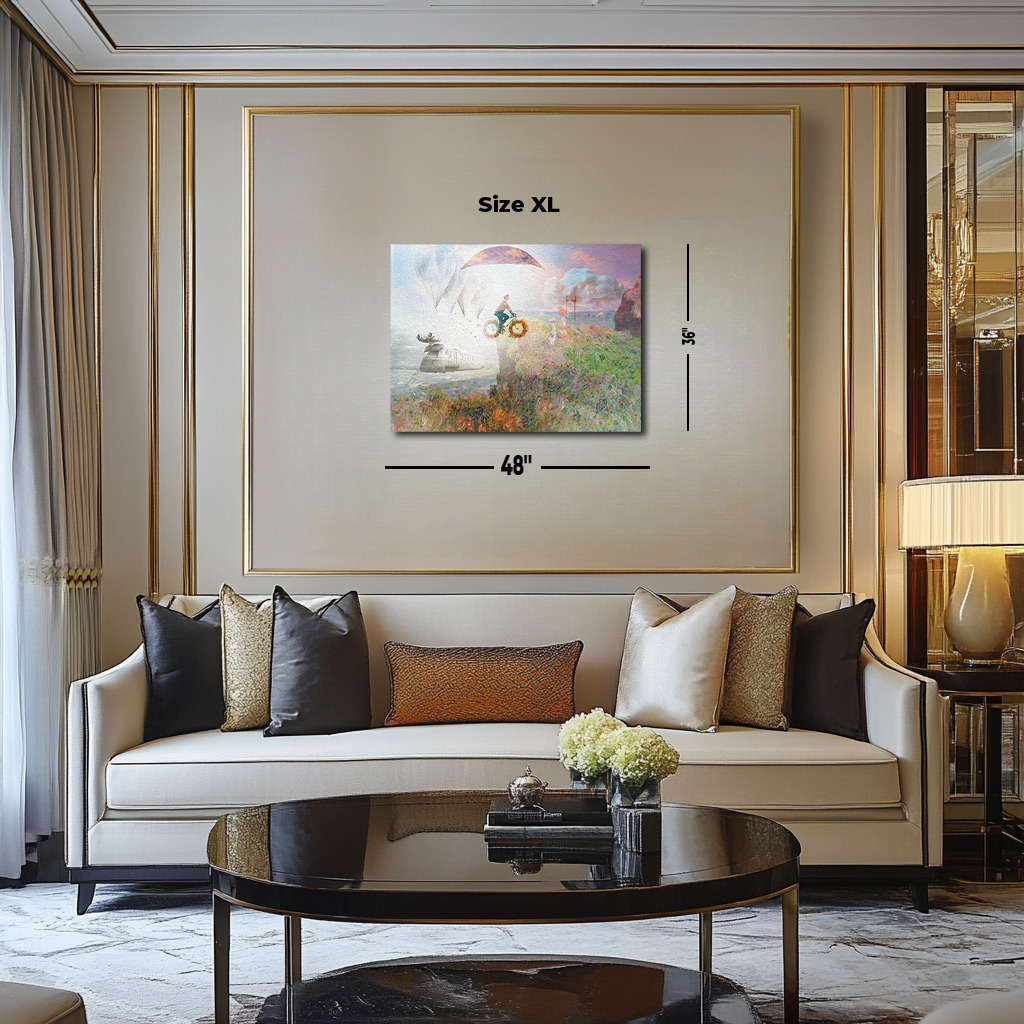Flight of Dreams: A Surreal Journey at Pourville
"Flight of Dreams: A Surreal Journey at Pourville" reimagines Claude Monet’s The Cliff Walk at Pourville by merging Impressionist tranquility with surrealist imagination. A bicyclist perched precariously on a cliff, a train suspended by balloons, and ethereal figures blend with vibrant wildflowers and soft-hued skies, creating a dreamlike narrative of motion and transformation. This reinterpretation explores themes of aspiration, imagination, and humanity’s connection to nature, bridging Monet’s legacy with contemporary art to evoke wonder, introspection, and the boundless potential of the human spirit.
Please see Below for Details…
Hotline Order:
Mon - Fri: 07AM - 06PM
404-872-4663
This breathtaking reinterpretation of Claude Monet’s The Cliff Walk at Pourville blends Impressionist sensitivity with surrealist imagination, transforming a serene coastal scene into a dynamic, dreamlike narrative. Monet’s original painting, created in 1882, captures the natural beauty of the cliffs at Pourville, a small village on the Normandy coast. With its soft light, vibrant colors, and the gentle motion of wind and waves, the original work evokes a sense of peace and introspection. In this reimagining, the timeless landscape becomes a canvas for surreal elements: a bicyclist balancing precariously on a cliff, a dirigible-like train carried by floating balloons, and ethereal figures in an endless dance with nature. These elements intertwine, creating a poetic meditation on human aspiration, nature, and the boundless possibilities of imagination.
Claude Monet’s The Cliff Walk at Pourville reflects his fascination with capturing fleeting moments of light and atmosphere. Painted during a period when Monet often visited the Normandy coast, the work embodies the Impressionist ideals of plein air painting, with its vivid depiction of natural light and movement. The cliff walk itself, with its sweeping views of the sea and sky, offered Monet an opportunity to explore the interplay of land, water, and air. His mastery of color and texture brought the scene to life, with delicate brushstrokes suggesting the gentle sway of grass, the lapping of waves, and the soft mist of the sea breeze.
In this surreal reinterpretation, the familiar elements of Monet’s coastal scene remain, but they are transformed into a fantastical vision that transcends reality. The cliffside, adorned with wildflowers in hues of green, pink, and yellow, serves as the foundation for the composition. The vibrant colors suggest vitality and renewal, echoing Monet’s original palette while amplifying its emotional resonance. Above the cliff, the sky is suffused with soft pinks, blues, and purples, evoking the ethereal beauty of dawn or dusk. These colors, symbolic of hope, introspection, and infinite possibility, set the tone for the surreal narrative that unfolds.
At the heart of the composition is a bicyclist, balancing precariously on the edge of the cliff. The bicycle’s wheels, composed of flower wreaths, suggest a connection to nature, as though the rider is propelled by the forces of the natural world. The figure’s poised yet uncertain position captures the tension between risk and possibility, a metaphor for the human journey and the pursuit of dreams. Above the rider, a large leaf-shaped parachute floats gently in the breeze, hinting at a sense of safety and freedom. This whimsical detail reinforces the surrealist theme, blurring the line between reality and fantasy.
To the left of the composition, a train-like structure, suspended by large white balloons, drifts gracefully through the sky. This dirigible-like creation juxtaposes industrial progress with the delicate beauty of nature, suggesting themes of innovation, exploration, and humanity’s evolving relationship with the environment. The train’s presence introduces a narrative of movement and transition, as though it is carrying passengers on a journey through both time and imagination. Its improbable flight, supported by fragile balloons, mirrors the precarious balance of the bicyclist, emphasizing the theme of vulnerability amidst ambition.
In the background, ethereal figures emerge from the wildflowers and mist, their forms blending seamlessly with the landscape. These ghostly presences suggest a connection to the past, as though they are memories or spirits inhabiting the timeless scene. Their inclusion adds depth and mystery to the composition, inviting viewers to reflect on their own connection to the natural world and the passage of time.
The colors in this artwork are central to its emotional impact. The warm pinks and yellows of the wildflowers convey joy and vitality, while the cooler blues and purples of the sky evoke calm and introspection. The interplay of light and shadow, a hallmark of Monet’s technique, is used here to create a sense of depth and movement, guiding the viewer’s gaze across the composition. The colors and textures work together to create a dreamlike atmosphere, where reality and fantasy coexist in harmonious balance.
As an artist, the decision to reinterpret The Cliff Walk at Pourville through a surrealist lens likely stems from a desire to explore the tension between the tangible and the imagined, the earthly and the ethereal. Monet’s original painting captures the beauty of a specific moment in nature, inviting viewers to immerse themselves in its tranquility. This reinterpretation expands on that theme, suggesting that even in the most serene settings, there is an undercurrent of motion, transformation, and possibility. The surreal elements—bicyclist, train, parachute—become metaphors for human aspiration, reminding viewers that the journey through life is as much about imagination as it is about reality.
The emotional resonance of this artwork lies in its ability to evoke a sense of wonder and introspection. The idyllic landscape, grounded in Monet’s Impressionist sensibilities, provides a sense of familiarity and comfort, while the surreal elements introduce a layer of mystery and excitement. Together, these components create a narrative that is both personal and universal, inviting viewers to reflect on their own journeys, dreams, and connections to the world around them.
This artwork is special because it bridges the gap between Impressionism and surrealism, honoring Monet’s legacy while pushing the boundaries of his vision. It celebrates the beauty of the natural world while exploring themes of innovation, aspiration, and the boundless potential of the human spirit. By combining the timeless elegance of Monet’s coastal scene with the imaginative freedom of surrealism, it creates a multidimensional narrative that resonates with viewers on both an emotional and intellectual level.
In conclusion, "Flight of Dreams: A Surreal Journey at Pourville" is a masterful fusion of Monet’s Impressionist brilliance and the limitless possibilities of contemporary art. It transforms a serene coastal landscape into a fantastical exploration of movement, imagination, and human connection, inviting viewers to embark on their own journey of wonder and reflection. Through its vibrant colors, dynamic composition, and layered symbolism, this artwork reminds us of the power of art to inspire, challenge, and illuminate the extraordinary in the everyday.
Add your review
Your email address will not be published. Required fields are marked *
Please login to write review!
Looks like there are no reviews yet.








